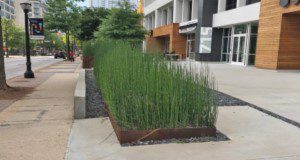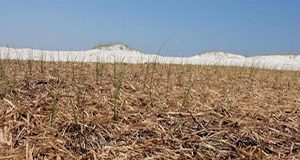Ornamental grasses create interest and excitement in the landscape with their unique characteristics. The availability of a large number of species and cultivars makes these plants very versatile, with many potential uses in the landscape. This publication outlines many of the considerations for the proper selection and use of ornamental grasses. The information and tables should assist the first-time gardener as well as the experienced landscaper in the selection and use of ornamental grasses in Florida. This 9-page major revision was written by Mack Thetford and Mary Salinas and published by the UF/IFAS Environmental Horticulture Department.
https://edis.ifas.ufl.edu/ep233
Tag: Mack Thetford
Dune Restoration Plants fact sheets
- Atlantic St. John’s Wort, Hypericum tenuifolium Synonym: Hypericum reductum
- Beach Morning-glory Ipomoea imperati and Railroad Vine Ipomoea pes-caprae subsp. brasiliensis
- Bitter Panicgrass, Bitter Panicum, Panicum amarum
- Coastal Groundcherry, Physalis angustifolia
- Coastal Sand Frostweed, Crocanthemum arenicola Synonym: Helianthemum arenicola
- Coastalplain Honeycombhead, Balduina angustifolia
- False Rosemary, Conradina canescens
- Florida Rosemary, Ceratiola ericoides
- Goldenaster, Chrysopsis
- Gopher Apple, Geobalanus oblongifolius Synonym: Licania michauxii
- Gulf Bluestem, Maritime Bluestem, Schizachyrium maritimum
- Gulf Coast Lupine, Lupinus westianus var. westianus
- Inkberry, Ilex glabra
- Myrtle Oak, Quercus myrtifolia
- October Flower, Polygonella polygama
- Sand Live Oak, Quercus geminata
- Sandhill Milikweed, Asclepias humistrata
- Sea Oats, Uniola paniculata
- Seabeach Evening Primrose, Oenothera humifusa
- Seacoast Marshelder, Iva imbricata
- Seaside Goldenrod, Solidago sempervirens
- Squareflower, Paronychia erecta
- Wax Myrtle, Morella cerifera Synonym: Myrica cerifera
- Woody Goldenrod, Chrysoma pauciflosculosa
- Yaupon, Ilex vomitoria
Dune Restoration and Enhancement for the Florida Panhandle
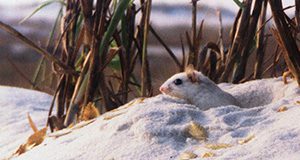
Published by the UF/IFAS Florida Sea Grant College Program, this manual provides an overview of the coastal ecosystems along the Florida Panhandle and shows how dunes can be restored and enhanced in this region of the Northern Gulf of Mexico.
In addition to direct experience acquired over many years of field work and experimentation, authors Chris Verlinde, Mack Thetford, and Debbie Miller consulted peer-reviewed academic journals, government documents, and various online resources to create the manual. Undergraduate and graduate students from the University of Florida and local professionals worked together with the UF/IFAS researchers to develop and test practical restoration techniques for Florida’s dunes.
http://edis.ifas.ufl.edu/sg156
Building Coastal Dunes with Sea Oats and Surrogate Wrack
Perennial coastal grasses such as sea oats have long been recognized as the biological engineers of our increasingly stressed beaches and coastal dunes. Sea oats build dunes by capturing blowing sand and stabilizing it, and they’re often planted after dunes have been eroded, fragmented, or destroyed. Managers have tried commercial fertilizers and water-absorbing gels to ensure planted sea oats survive and thrive, but these products are not always effective and can be expensive. Removal of natural beach litter, called “wrack” and defined as “algae, grasses, driftwood, fruits, seeds, and carrion, along with cultural litter,” has frequently had the undesired effect of weakening the establishment and growth of sea oats. A relatively cheap and effective method to restore them is to reproduce the beneficial effects of this beach litter with “surrogate wrack.” This 4-page fact sheet written by Natalie Hooton, Debbie Miller, Mack Thetford, and Sean Claypool and published by the Department of Wildlife Ecology and Conservation describes the promising results of a study into the feasibility and effectiveness of surrogate wrack to help sea oats become established and grow more quickly and vibrantly to restore dunes and beaches.
edis.ifas.ufl.edu/uw409
Guide to Olive Tree Nutrition in Florida
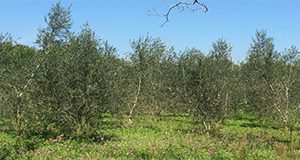 A burgeoning olive industry already exists in the southeastern United States, but research and Extension information regarding olive fertilization recommendations in Florida is limited. While there are data and recommendations for olive from the University of California, the University of Georgia (UGA), and other institutions around the world, there are no data from which we can derive Florida-specific recommendations. This 6-page fact sheet uses many of the existing recommendations for mature, high-density, and traditional grove spacing as guidelines until data specific to Florida production are generated. It discusses leaf tissue sampling procedures, leaf tissue sufficiency ranges, nitrogen fertility, phosphorus and potassium fertility, boron, concerns for olive production in Florida, and other resources for olive production in the state. Written by Michael J. Mulvaney, Rao Mylavarapu, Peter C. Andersen, Mack Thetford, and Jennifer L. Gillett-Kaufman, and published by the UF Agronomy Department, May 2016.
A burgeoning olive industry already exists in the southeastern United States, but research and Extension information regarding olive fertilization recommendations in Florida is limited. While there are data and recommendations for olive from the University of California, the University of Georgia (UGA), and other institutions around the world, there are no data from which we can derive Florida-specific recommendations. This 6-page fact sheet uses many of the existing recommendations for mature, high-density, and traditional grove spacing as guidelines until data specific to Florida production are generated. It discusses leaf tissue sampling procedures, leaf tissue sufficiency ranges, nitrogen fertility, phosphorus and potassium fertility, boron, concerns for olive production in Florida, and other resources for olive production in the state. Written by Michael J. Mulvaney, Rao Mylavarapu, Peter C. Andersen, Mack Thetford, and Jennifer L. Gillett-Kaufman, and published by the UF Agronomy Department, May 2016.
http://edis.ifas.ufl.edu/ag405
Olives for Your Florida Landscape
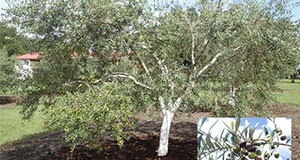 Olives have great potential as a landscape ornamental and may also provide opportunities for home fruit production. However, as a relatively new commercial crop to Florida, the cultural requirements of these trees are not completely known and research is ongoing to understand how to manage them for plant health and fruit yield as well as to make recommendations on varietal selections best suited to the southeastern region of the United States. This 5-page fact sheet includes culture and management information, selected references, and a table listing a selection of olive cultivars currently available in the U.S. Written by Mack Thetford, Jennifer L. Gillett-Kaufman, Michael J. Mulvaney, and published by the UF Department of Environmental Horticulture, February 2015.
Olives have great potential as a landscape ornamental and may also provide opportunities for home fruit production. However, as a relatively new commercial crop to Florida, the cultural requirements of these trees are not completely known and research is ongoing to understand how to manage them for plant health and fruit yield as well as to make recommendations on varietal selections best suited to the southeastern region of the United States. This 5-page fact sheet includes culture and management information, selected references, and a table listing a selection of olive cultivars currently available in the U.S. Written by Mack Thetford, Jennifer L. Gillett-Kaufman, Michael J. Mulvaney, and published by the UF Department of Environmental Horticulture, February 2015.
http://edis.ifas.ufl.edu/ep515
